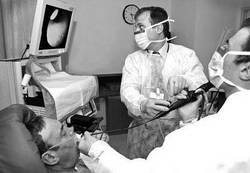A Subsequent Rise in Medicine Personalization
 As the lines separating biology, chemistry and computer science have yet again been blurred, new roads have been paved for the scientific advancements of tomorrow to begin today.
As the lines separating biology, chemistry and computer science have yet again been blurred, new roads have been paved for the scientific advancements of tomorrow to begin today.
Genes are the units of heredity in living organisms. They are composed of stretches of DNA and RNA that code for other RNA chains and proteins, one of the chief building blocks of life. A decade ago, an international collaboration of scientists in the Human Genome Project successfully mapped and identified all of the genes that make up the human genome, the aggregate sum of all our genetic makeup – the cost of doing so, however, ran in the billions of dollars.
Recently, Bill Banyai, an optical physicist at Complete Genomics, designed a factory that, according to the New York Times,“automated and greatly lowered the cost of mapping the three billion base pairs that form the human genome.” His company is pushing to reduce that cost to under $1000, the applications of which are simply jaw dropping.
Young fields such as personalized medicine, gene therapy and genetic counseling will mature into integral parts of tomorrow’s medicine, branching out new lines of careers in bioinformatics, applied computing and molecular genetics, to name a few.
The advent of personalized medicine in particular will bring forth the most visible change in the near future. Patients can be treated on a case-by-case basis on an unprecedented level of specificity, one down to the molecular level of their own genetic makeup. This will allow doctors and biotechnology companies to pinpoint the errors in genes that predispose individuals to certain diseases such as cystic fibrosis, breast cancer and Alzheimer’s.
Other ways personalized medicine will evolve include the development of pharmacogenetics—a way for drug companies to tailor drugs to specifically match a patient’s needs and reduce the odds of adverse drug reactions—and gene therapy, a way of using healthy genes to replace defective genes to bolster immunity to disease.
According to the National Institutes of Health, “Having the essentially complete sequence of the human genome is similar to having all the pages of a manual needed to make the human body.” The challenge awaiting researchers will be to determine how to read the contents of such pages and then to understand how the parts work together and to discover the genetic basis for health and the pathology of human disease.
The United States Department of Energy and the National Institutes of Health have created the field of genomics, dedicated to understanding genetic material on a macro scale.
Payal Patel, a junior double majoring in chemistry and biology, feels that, “Lowering the cost of gene sequencing to a reasonable price will open up many new opportunities for researchers and can provide us a better understanding about the molecular functions of the human body.”
A surprising parallel, according to the New York Times,can be drawn between the advancement of the gene sequencing industry and that of the Silicon Valley semiconductor makers. “By placing more circuits on a silicon wafer at an exponentially increasing pace since the early 1960s, the semiconductor industry transformed the cost of computing.”
Consequentially, the most powerful supercomputer from 30 years ago can now fit in the palm of your hand and set reminders, record high definition video and launch Angry Birds through the touch of a single button. As more and more sensors are “packed into each successive generation of technology, the cost of sequencing will also fall sharply,” reported by the New York Times.
Genome-based research in this regard will soon enable researchers to develop diagnostic tools of the highest efficacy, allowing physicians to directly understand the needs of their patients based on their individual genetic make-ups.
“This will immensely benefit hot new research in pathology and oncology,” remarked Patel. Although we all have 99 percent similar gene sequences, there is that one percent difference which sometimes is the reason for rare diseases. Knowing the complete sequence of DNA will give pathologists and oncologists a better understanding of each patient that was not available before.
“Given the speed with which this technology is moving forward,” said Dr. Robin Kucharczyk, chemistry professor, “we can’t start soon enough to discuss the policy issues (for example, information security, insurance reimbursement, limits of dissemination) that will need to be addressed before genome sequencing is made routinely available. Personalized medicine may be able to extend and save lives, but misuse of information could ruin lives as well.”
Conrad Sawicki, a junior chemistry major, feels, “Many opportunities open up with genetic sequencing becoming common place … imagine a huge security breach of your genetic flaws being exposed.” For the safety of the populace, the emergence of such a new frontier must be equipped with the appropriate measures to prevent such consequences.
This individualized analysis will yield a force of preventive medicine to be reckoned with. Risks of future illness based on DNA analysis will be able to be analyzed. Medicine may become even more collaborative as physicians may need the expertise of genetic counselors and geneticists to understand the genetic sequence of the patient, and then with nurses and other healthcare professionals, deliver the appropriate personalized care the patient deserves.
We have now reduced the cost of sequencing the human genome from the billions of dollars, at the culmination of the Human Genome Project a decade ago, to $1000. According to the New York Times, Dr. Clifford Reid, CEO of Complete Genomics, predicts, “in the next few years, the cost of gene sequencing could eventually be low as that of a blood test.”
IMAGE TAKEN from wbur.org



